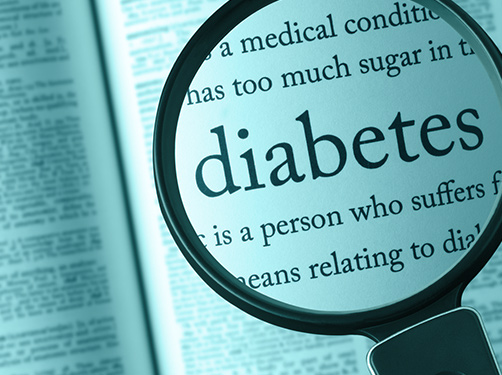Exercise and type 2 diabetes
Scientific support: Prof. Dr. Dominik Pesta
Sports and exercise not only help prevent type 2 diabetes, they also have a positive effect on anyone who already has diabetes. This is because physical activity of any kind prompts cells within the body to absorb sugar (glucose) from the blood. This reduces the level of glucose in the blood. Regular exercise improves the sensitivity of the body’s cells to insulin, so more glucose can be absorbed from the blood into the cells. In the medium term, this can help lower the long-term blood glucose level (HbA1c value).
In addition to its positive effects on diabetes, regular exercise also strengthens the cardiovascular system and lowers blood pressure. It also has a positive effect on the onset and development of diabetes-related complications.
Overall, regular exercise is an important part of a healthy lifestyle: Physical activity improves well-being, strengthens self-esteem and promotes social interaction.

Contents
- How much should I exercise with type 2 diabetes?
- What types of sport are suitable for people with type 2 diabetes?
- What are the benefits of regular exercise?
- Can type 2 diabetes be reversed through exercise?
- What should people with type 2 diabetes consider when starting or returning to exercise ?
- What should people with insulin-dependent diabetes bear in mind when exercising?
1. How much should I exercise with type 2 diabetes?
As a general rule, any additional movement is associated with health benefits.
According to current World Health Organization (WHO) recommendations, adults aged 18 to 65 years should exercise at least 150 to 300 minutesper week at moderate intensity. It also suggests that exercising more than the recommended 300 minutes (5 hours) per week will result in additional health benefits. Possible activities include, for example, cycling, walking, jogging, or swimming. This recommendation also applies to people with type 2 diabetes. Dividing workouts into 30 to 60 minute units 3 to 4 times a week is ideal. Alternatively, the WHO recommends at least 75 to 150 minutes per week of higher-intensity physical activity. Various studies have also shown that exercising after meals in particular can improve blood glucose control by attenuating acute blood glucose spikes.
Whether one is exercising at a moderate or higher intensity can easily be determined by their ability to speak. Activities of moderate intensity speed up breathing. However, speaking during exercise is possible. At higher intensities, breathing is accelerated even more, which makes talking more difficult.
It is also recommended to incorporate as much movement as possible – whenever possible – into everyday life. For example:
- Taking the stairs instead of the elevator or escalator
- Walking to a bus or train stop that's farther away instead of heading to the nearest station
- Covering short distances on foot or by bike instead of by car
Taking a stroll or doing some light gardening are also suitable ways to increase daily activity. Such light movements also lower the blood sugar level.
Sitting for long periods is particularly unhealthy. It's not without reason that sitting is often referred to as "the new smoking." Reducing the amount of time spent sitting each day and taking active breaks at least every 30 minutes, even brief ones, can help prevent back problems, weight gain and obesity, blood vessel blockages, and muscle loss.
In addition to endurance training, the WHO recommends a moderate strength training program at least twice a week. Such program should target all the major muscle groups. For people 65 and older, balance and coordination exercises are also recommended in order to prevent falls.
Good to know:
Especially for older and untrained people, the WHO recommendations can seem very extensive and difficult to implement. However, the good thing is: Every movement counts. So those who only manage 10 or 20 minutes of physical activity at a time still achieve positive health effects. It is advisable to start with short exercise intervals. The frequency, intensity and duration of the exercise can then be slowly increased.
2. What types of sport are suitable for people with type 2 diabetes?
A combination of endurance and strength training is recommended for both people with type 2 diabetes and those without. Suitable endurance sports include Nordic walking, brisk walking or hiking, jogging, mountain hiking, skiing, cross-country skiing, swimming, cycling, inline skating, dancing or table tennis. In addition to endurance sports, experts recommend strength training for the large muscle groups such as thighs, abdomen and back.
Individuals with type 2 diabetes aged 40 years or older should also particularly promote dexterity, responsiveness, coordination, joint flexibility, and agility to reduce the risk of falls. Yoga, Pilates, Qigong, Tai-Chi or stretching exercises, for example, are suitable for this.
For people with type 2 diabetes who are overweight and/or have physical limitations, and for anyone who wants to start exercising again after a long break, activities such as aqua training are a suitable. Exercising in the water is easy on the joints and back, and the resistance of the water makes aqua-jogging, aqua-walking and aqua-gymnastics particularly effective. So-called chair fitness is also an option, which involves various exercises while sitting.
In general, people with type 2 diabetes are able to participate in all kinds of physical activities. However, depending on their diabetes treatment, regular monitoring of blood glucose levels is required. Therefore, before starting any new activity, it is recommended that individuals discuss the possible risks and a suitable approach with their doctor.
Special preparation and training are necessary for extreme sports, taking into account the individuals diabetes treatment. This is especially important for extreme activities that take place in the water or in the air, such as hang gliding, parachuting or scuba diving. During these sports, it may be difficult to take appropriate countermeasures in good time should a metabolic derailment occur, e.g. hypoglycemia (low blood sugar).
diabinfo.de offers various training plans for individuals looking to start exercising or add variety to their existing workout routines. Have fun trying them out!
Good to know:
Any movement is better than no movement. The most important thing is that the sport should be fun.
3. What are the benefits of regular exercise?
Exercise increases the rate at which sugar (glucose) is absorbed from the blood into the body's cells to provide needed energy. This reduces the level of glucose in the blood. Furthermore, regular physical activity in people with type 2 diabetes improves the insulin sensitivity of muscle cells. This means that the cells respond better to insulin again and absorb more sugar from the blood. This has a positive effect on existing insulin resistance.
By following a long-term and regular exercise program in line with WHO recommendations (30 to 60 minutes of endurance training 3 to 4 times a week and strength training 2 times a week), it is possible for people with type 2 diabetes to lower their blood glucose levels enough to eliminate the need for blood glucose-lowering medication.
In addition, regular exercise can support weight loss due to the body’s increased need for energy and the reduction of fat reserves for energy production: This is because the body consumes energy whenever it engages in physical activity. The more you move, the more calories you burn. Physical activity also works to "naturally" reduce blood pressure and cholesterol. It also has a direct effect on heart health, as regular physical activity also exercises the heart muscle and reduces stress levels. A well-exercised heart needs fewer beats to pump oxygen-rich blood throughout the body. As a result, people who exercise regularly have a lower resting heart rate.
During physical activity, muscles also release messenger substances, so-called myokines, which have positive effects throughout the body and thus strengthen the cardiovascular system, among other things, and can also prevent type 2 diabetes.
The best part: Exercise has been proven to make people happy. After strenuous physical activity, the central nervous system and the pituitary gland release endorphins. These so-called "happiness hormones" give the body a "good feeling".
Everyone benefits equally from the positive effects of exercise on the cardiovascular system, muscles, joints and well-being. In addition, regular exercise also supports the benefits of type 2 diabetes therapy.
Overall, regular and adequate exercise in people with type 2 diabetes leads to
- an increased quality of life.
- a temporary increase in insulin sensitivity and decrease in blood glucose.
- a reduced risk of cardiovascular disease.
- an improvement in strength, endurance and mobility.
- positive effects on general body functions.
- positive effects on sleep apnea and depression.
4. Can type 2 diabetes be reversed through exercise?
Type 2 diabetes is largely caused by an unhealthy lifestyle involving lack of exercise, unhealthy diet, obesity and smoking. A comprehensive lifestyle change, characterized in particular by weight loss and dietary changes, as well as regular and sufficient exercise, can not only prevent the disease, but also reverse it – at least temporarily. This is especially true for overweight people who have only recently developed type 2 diabetes. In this context, experts speak of a remission. Remission is achieved when blood glucose levels remain at near-normal levels without the use of blood glucose-lowering medications.
More information about diets for type 2 diabetes can be found here.
5. What should people with type 2 diabetes consider when starting or returning to exercise ?
People with diabetes who want to start exercising again after a long break should consult their doctor, who may want to perform a physical examination first. The doctor can assess whether the individual is fit to participate in physical activity, clarify possible risks and give advice on suitable beginner exercises. A sports medicine examination can also be informative with regard to an appropriate exercise program. In particular, patients taking blood glucose-lowering medications such as sulfonylureas or glinides or injecting insulin should seek medical advice before starting an exercise program. as these drugs can cause hypoglycemia. To avoid metabolic derailment, a different dosage of medication may be necessary.
In addition, any existing concomitant and secondary diseases should be taken into account when choosing an exercise regimen. Persons with an existing eye disease (diabetic retinopathy) should avoid intensive weight training and martial arts due to the increased health risk. Overweight people with diabetes and a nerve disease (diabetic neuropathy) should opt for sports such as swimming, water aerobics or cycling for a joint and body-friendly load. When walking briskly or Nordic walking, be sure to wear suitable footwear.
For newcomers and those who do not want to exercise alone, sports groups specifically for people with diabetes are suitable. Training in a group makes it easier to (re)start, promotes social interaction and offers professional advice. The groups are run by exercise instructors who are specially trained to coach people with diabetes.
There are numerous sports groups for people with diabetes throughout Germany. For example, the following institutions provide an overview (Websites in German):
- Working Group Diabetes, Sport and Exercise of the German Diabetes Association (DDG)
- German Sports Association for the Disabled
- diabetesDE – German Diabetes Aid
- German pension insurance
Health insurance companies now subsidize many health courses and, above all, rehabilitation sports.
6. What should people with insulin-dependent diabetes bear in mind when exercising?
Exercise decreases the insulin requirement of the body's cells. Therefore, depending on the intensity and duration of activity, it is important to adjust the insulin dose and/or carbohydrate intake to avoid hypoglycemia.
Too low an insulin level can, in turn, lead to an insulin deficiency, preventing sugar (glucose) in the blood from being absorbed into the muscles and causing hyperglycemia.
It is important to monitor blood glucose before, during and after exercise to prevent severe blood glucose fluctuations. People with diabetes should keep in mind that hypoglycemia can occur even several hours after physical activity. Therefore, blood glucose should be checked several times even after the exercise session.
In addition to blood glucose monitoring equipment, people with insulin-dependent diabetes should always have carbohydrate-containing foods, such as dextrose or juice, as well as rapid-acting insulin and glucagon, on hand during exercise. In addition, it is advisable to inform other members in the sports group as well as the exercise instructor about your own diabetes.
Sources:
American Diabetes Association: Standards of Medical Care in Diabetes – 2022. In: Diabetes Care, 2022, 45: S1-S264
Bundesärztekammer et al.: Nationale Versorgungsleitlinie Typ-2-Diabetes. Langfassung. Version 3.0. 2023
Bundesärztekammer et al.: Nationale Versorgungsleitlinie Therapie des Typ-2-Diabetes. Langfassung. 1. Auflage. Version 4. 2014 (Gültigkeit abgelaufen, in Überarbeitung)
Dhankhar, S. et al.: Novel targets for potential therapeutic use in Diabetes mellitus. In: Diabetol Metab Syndr, 2023, 15: 17
Esefeld, K. et al.: Diabetes, Sport und Bewegung. In: Diabetologie, 2022, 17: S301-S310
Gibbs, B. B. et al.:Physical Activity as a Critical Component of First-Line Treatment for Elevated Blood Pressure or Cholesterol: Who, What, and How?: A Scientific Statement From the American Heart Association. In: Hypertension, 2021, 78:e26-e37
Graf, S. et al. (2021): Fitness fürs Immunsystem: Wie Ausdauersport die Abwehrkräfte stärkt. 1. Auflage. Delius Klasing Verlag, Bielefeld, ISBN: 978-3-667-12200-1
Igarashi, Y. et al.: Response of lipids and lipoproteins to regular aquatic endurance exercise: A meta-analysis of randomized controlled trials. In: J Atheroscler Thromb, 2019, 26: 14-30
Kanaley, J. A. et al.:Exercise/Physical Activity in Individuals with Type 2 Diabetes: A Consensus Statement from the American College of Sports Medicine. In: Med Sci Sports Exerc, 2022, 54: 353-368
Landgraf, R. et al.: Therapie des Typ-2-Diabetes. In: Diabetologie, 2022, 17: S159-S204
Lean, M. E. et al.: Primary care-led weight management for remission of type 2 diabetes (DiRECT): an open-label, cluster-randomised trial. In: Lancet, 2018, 391: 541-551
Mach, F. et al.: 2019 ESC/EAS 2019 Guidelines for the management of dyslipidaemias: lipid modification to reduce cardiovascular risk. In: Eur Heart J, 2020, 41: 111-188
Pedersen, B. K. et al.: Exercise as medicine – evidence for prescribing exercise as therapy in 26 different chronic diseases. In: Scand J Med Sci Sports, 2015, 25: 1-72
Rütten, A. et al. (Hrsg.): Nationale Empfehlungen für Bewegung und Bewegungsförderung. FAU Erlangen-Nürnberg, 2016
Thurm, U. et al. (2018): Diabetes- und Sportfibel: Mit Diabetes weiter laufen. 4. Auflage. Kirchheim-Verlag, Mainz, ISBN: 978-3-87409-630-0
World Health Organization: Global status report on physical activity 2022. 2022
World Health Organization: Guidelines on physical activity and sedentary behavior. 2020
As of: 12.06.2023






